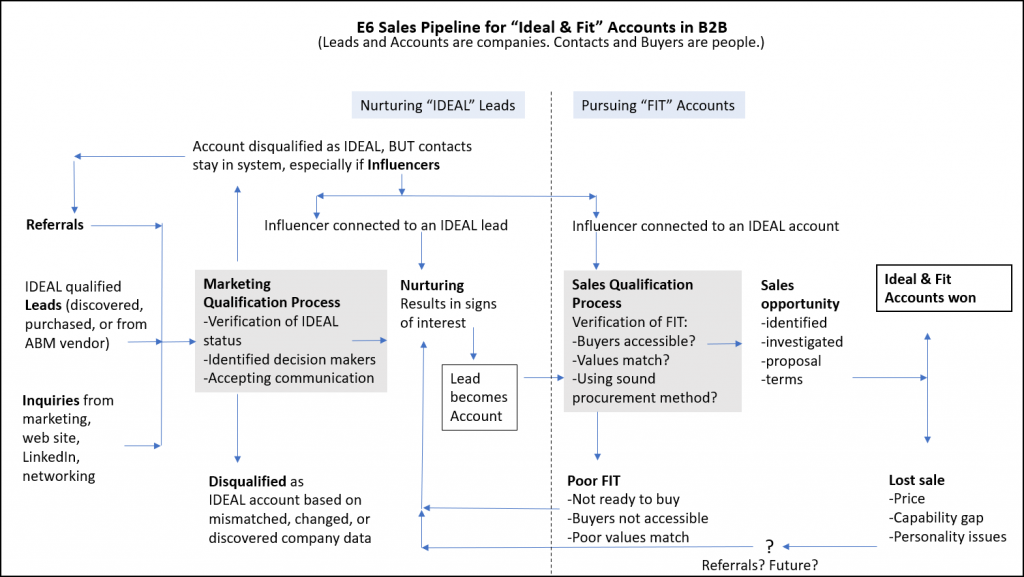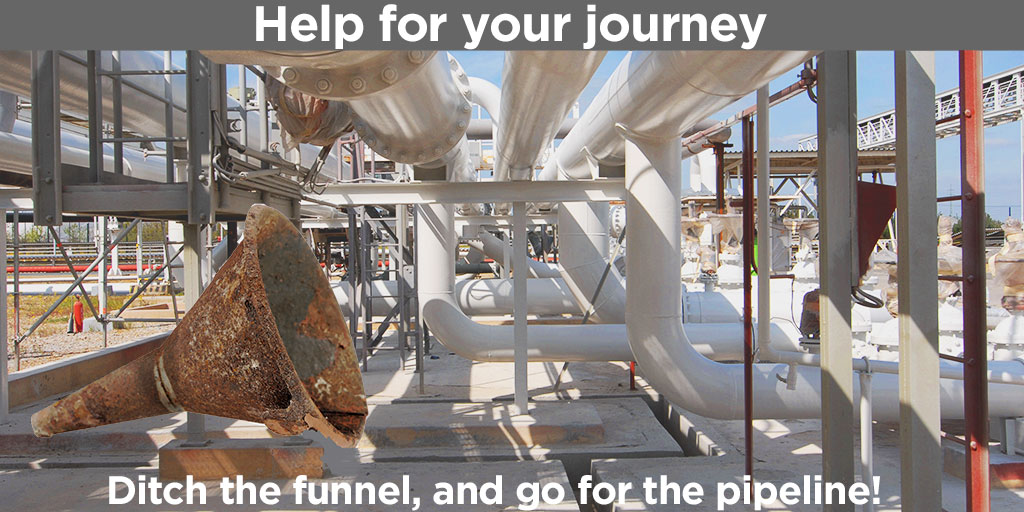Why define a sales pipeline? Are you frustrated with low-quality leads that waste time and butcher sales productivity? Then consider ditching your sales funnel for a pipeline. A sales pipeline delivers profitable, long-lasting accounts.

At E6 Solutions, we can help you define a sales pipeline for acquiring “ideal & fit” accounts. First, you plan the right inflows and outflows around your leads and accounts. Then, you define a lead-scoring process that creates value for your organization. Plus, this pipeline will allow you to automate the process. Instead of entering and managing data, your people can focus on finding opportunities.
What defines a sales pipeline?
To define a sales pipeline, we create a set of processes to acquire, manage and convert leads. These processes are designed to focus the human effort of marketing and selling on the most desirable new business. The system can be manual, but its power lies in a cheap platform that offloads every possible step from humans. Machines can’t write a persuasive blog post or build a relationship. So the pipeline frees humans up to do their best work.
What are “ideal & fit” accounts?
If you are frustrated by the low productivity of your marketing and sales team, now is the time to re-evaluate your lead acquisition. We recommend you stop feeding a funnel with leads of mixed quality. First, you’ll need to define an Ideal Account Profile. Then you can zero in on prospects who are a good match to your company’s strengths. No longer will your people try to persuade incompatible companies to buy. Soon you will have an efficient and predictable marketing and sales process. Plus, it becomes easier to get the right referrals from all your connections.
The “Ideal Account Profile” is a hard, quantifiable measure that can be leveraged by your information system. Using a lead-scoring process, every IAP gets a ranked priority. Verifying “Account Fit” is a human process, performed by someone on your staff who interacts with the people at an identified “ideal account.” Once you are sure that an account is an ideal match to your strengths, check for a good fit between your two companies. Then you can focus your efforts on pursuing opportunities.
Expert advice on “ideal” and “fit” accounts
The term “ideal” may mean different things to different organizations. Ahead of building your IAP, it’s worth defining what’s important to your organization. For example, “ideal” may mean highest revenue, most profitable or even lowest risk of churn. Gaining agreement around the notion of an ideal account helps create the alignment for future stages of building your IAP…. To start defining your IAP, you need clarity on how you create value for your target customers and which types of customers you’ve been most successful with in the past.
From Quarry Fresh Ideas: So you want to create an ideal account profile…, January 10, 2020
For most, creating your ICP [or IAP] is easier than identifying what criteria make for a good fitting customer. Black and white characteristics are easier to spot without needing to have a conversation with someone. An example of fit criteria for your sale might be that your decision influencers (audience, buyers, decision-makers, etc.) need to be accessible. That’s a simple criterion that can be identified as either a “yes they are” or “no they’re not.” Another might be that all the decision influencers are engaged in their role and open in their communication.
To help you identify the difference between ICP [or IAP] and Customer Fit, look back on the last 12 months and select a handful of important sales opportunities that were lost or didn’t go your way. How many of these met your ICP, but you don’t know if they were “a good fit?” Was the prospect open and honest? Were all the people accessible that needed to be reached? If you answered “no” to either, it’s likely they were not a good fit.
From The Millau Group: Customer Fit Versus Ideal Customer Profile – The Difference and Why It’s Important by Colin Longren
Fit can change over time. A “poor fit” may stay in nurturing during that time. Even if they unsubscribe or ignore all communication, they can be kept as a lead, pending changes at the company. The pipeline also has a place for contacts and influencers who aren’t working at ideal accounts.

How do we Build a Sales Pipeline for our Company?
To define a sales pipeline, we have to step up from just using an application for customer relationship management (CRM). Instead, we use full-fledged business process management. The CRM holds important data, but the sales pipeline uses “weights and gates” on this data. In this way, only leads that have an appropriate lead score get further handling. Of course, the pipeline has plenty of feedback loops so leads can be nurtured. More importantly, the system directs our staff’s attention to the most promising prospects.
Your sales pipeline has 3 main ways of receiving leads: inquiries, referrals and IDEAL leads. IDEAL Leads are normally purchased from a data provider or an Account-Based Marketing firm. Purchased data should be ready for nurturing. However, the pipeline application first scores the leads. Inquiries and referrals should always go through Marketing Qualification. In that way, contacts who don’t work at IDEAL accounts can be downgraded unless they are found to be influencers. Even then, they receive low or no lead score, and do not proceed through the pipeline. If a contact works at a company that is not a qualified lead, then no account record needs to be created.
The nurturing process includes
- email and phone introductions
- distributions of company literature
- newsletters
- invitations.
Automated drip email campaigns can be very valuable if the account needs have been recognized. However, drip marketing may be damaging if it doesn’t reflect the real concerns of an account.
Converting a Prospect to a Customer
One important juncture in the pipeline is the hand-off from marketing staff to sales staff. In a business-to-business sales pipeline, the sales people focus on identifying opportunities within their accounts. The Sales Qualification process is designed to help sales people find opportunities, not to just build a relationship. The relationship-building skills are key, but the process is focused on the opportunity.
To help the sales people close in on the right opportunity, he/she/they follow a Sales Qualification process. It verifies whether a prospect can make a purchase within an acceptable time frame. The sales person then works to close the opportunity, not the account. The Sales Qualification process revolves around 3 questions of FIT:
- Do I have the person who can make the purchase?
- Does this person appreciate the benefit we provide?
- Is there a dependable buying process in place?
If the sales person doesn’t have 3 yeses, then the sales opportunity is poor, and the account should be sent back to nurturing as a “Poor FIT.”
Why is the sales pipeline more complicated than the sales funnel?
In real life, marketing, selling, and purchasing processes are complicated. It would be great if every prospect agreed to move down the funnel, but they have a funny way of going back up. Or sideways. And then they bring up issues that no one had considered. Defining a sales pipeline is more complicated, but it gives the marketing and sales people a more efficient work path. AND it lets the prospect take a loop back if they aren’t ready to proceed, without getting lost.

